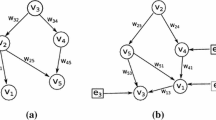Abstract
Causal diagrams provide a graphical formalism indicating how statistical models can be used to study causal processes. Despite the extensive research on the efficacy of aesthetic graphic layouts, the causal inference domain has not benefited from the results of this research. In this paper, we investigate the performance of graph visualisations for supporting users’ understanding of causal graphs. Two studies were conducted to compare graph visualisations for understanding causation and identifying confounding variables in a causal graph. The first study results suggest that while adjacency matrix layouts are better for understanding direct causation, node-link diagrams are better for understanding mediated causation along causal paths. The second study revealed that node-link layouts, and in particular layouts created by a radial algorithm, are more effective for identifying confounder and collider variables.
Access this chapter
Tax calculation will be finalised at checkout
Purchases are for personal use only
Similar content being viewed by others
References
Allender, S., et al.: A community based systems diagram of obesity causes. PLoS One 10(7), e0129683 (2015)
Bae, J., et al.: Develo** and evaluating quilts for the depiction of large layered graphs. IEEE TVCG 17(12), 2268–2275 (2011)
Behrisch, M., et al.: Matrix reordering methods for table and network visualization. Comput. Graph. Forum 35(3), 693–716 (2016)
Bennett, C., et al.: The aesthetics of graph visualization. In: Proceedings of the 2007 Computational Aesthetics in Graphics, Visualization, and Imaging, pp. 57–64 (2007)
Braveman, P., Gottlieb, L.: The social determinants of health: it’s time to consider the causes of the causes. Public Health Rep. 129(2), 19–31 (2014)
Burch, M., et al.: Evaluation of traditional, orthogonal, and radial tree diagrams by an eye tracking study. IEEE TVCG 17(12), 2440–2448 (2011)
Dang, T., et al.: ReactionFlow: an interactive visualization tool for causality analysis in biological pathways. BMC Proc. 9, S6 (2015)
Di Battista, G.: Graph Drawing: Algorithms for the Visualization of Graphs. An Alan R. Apt Book. Prentice Hall, Upper Saddle River (1999)
Draper, G., et al.: A survey of radial methods for information visualization. IEEE Trans. Vis. Comput. Graph. 15(5), 759–776 (2009)
Elmqvist, N., Tsigas, P.: Causality visualization using animated growing polygons. In: Proceedings of IEEE Information Visualization 2003, vol. 2003, pp. 189–196. IEEE (2003)
Garaigordobil, M., et al.: Childhood depression: relation to adaptive, clinical and predictor variables. Front. Psychol. 8(MAY), 1–9 (2017). https://doi.org/10.3389/fpsyg.2017.00821
Ghoniem, M., et al.: A comparison of the readability of graphs using node-link and matrix-based representations. In: Proceedings of IEEE Information Visualization, pp. 17–24 (2004)
Government, U.: Reducing obesity: obesity system map, tackling obesities: future choices – building the obesity system map (2007). https://www.gov.uk/government/publications/reducing-obesity-obesity-system-map
Heer, J., Robertson, G.: Animated transitions in statistical data graphics. IEEE TVCG 13(6), 1240–1247 (2007)
Henry, N., Fekete, J.D.: MatrixExplorer: a dual-representation system to explore social networks. IEEE TVCG 12(5), 677–684 (2006)
Henry, N., et al.: NodeTrix: a hybrid visualization of social networks. IEEE Trans. Vis. Comput. Graph. 13(6), 1302–1309 (2007)
Higgins, J.J., Tashtoush, S.: An aligned rank transform test for interaction. Nonlinear World 1(2), 201–211 (1994)
Keatley, D.A., et al.: Lay understanding of the causes of binge drinking in the United Kingdom and Australia: a network diagram approach. Health Educ. Res. 32(1), cyw056 (2017)
Keller, R., et al.: Matrices or node-link diagrams: which visual representation is better for visualising connectivity models? Inf. Vis. 5(1), 62–76 (2006)
von Landesberger, T., et al.: Visual analysis of large graphs: state-of-the-art and future research challenges. Comput. Graph. Forum 30(6), 1719–1749 (2011)
Liiv, I.: Seriation and matrix reordering methods: an historical overview. Stat. Anal. Data Min. 8(5), 70–91 (2010)
McGrath, C., et al.: The effect of spatial arrangement on judgments and errors in interpreting graphs. Soc. Netw. 19(3), 223–242 (1997)
McQuire, C., et al.: The causal web of foetal alcohol spectrum disorders: a review and causal diagram. Eur. Child Adolesc. Psychiatr. 29(5), 575–594 (2019). https://doi.org/10.1007/s00787-018-1264-3
Pearl, J.: Causal diagrams for empirical research. Biometrika 82(4), 669–688 (1995)
Purchase, H.C., et al.: Empirical evaluation of aesthetics-based graph layout. Empir. Softw. Eng. 7(3), 233–255 (2002)
Roberts, J.C.: State of the art: coordinated & multiple views in exploratory visualization. In: Fifth International Conference on Coordinated and Multiple Views in Exploratory Visualization (CMV 2007), pp. 61–71. IEEE (2007)
Scheines, R., et al.: The TETRAD project: constraint based aids to causal model specification. Multivar. Behav. Res. 33(1), 65–117 (1998)
Shen, Z., Ma, K.L.: Path visualization for adjacency matrices. In: Museth, K., et al. (eds.) Eurographics/ IEEE-VGTC Symposium on Visualization. The Eurographics Association (2007)
Sugiyama, K., Misue, K.: Visualization of structural information: automatic drawing of compound digraphs. IEEE Trans. Syst. Man Cybern. 21(4), 876–892 (1991)
Textor, J., et al.: DAGitty: a graphical tool for analyzing causal diagrams. Epidemiology (Cambridge, Mass.) 22(5), 745 (2011)
Vehlow, C., Beck, F., Weiskopf, D.: The state of the art in visualizing group structures in graphs. In: Borgo, R., et al. (eds.) Eurographics Conference on Visualization (EuroVis) - STARs. The Eurographics Association (2015)
Wang, J., Mueller, K.: The visual causality analyst: an interactive interface for causal reasoning. IEEE TVCG 22(1), 230–239 (2016)
Wobbrock, J.O., et al.: The aligned rank transform for nonparametric factorial analyses using only anova procedures. In: Proceedings of CHI 2011, p. 143. ACM Press, New York (2011)
Wright, S.: Correlation and causation. J. Agric. Res. 20(7), 557–585 (1921)
yWorks: yEd Graph Editor. http://www.yworks.com/products/yed
Author information
Authors and Affiliations
Corresponding author
Editor information
Editors and Affiliations
Rights and permissions
Copyright information
© 2020 Springer Nature Switzerland AG
About this paper
Cite this paper
Vo, DB., Lazarova, K., Purchase, H.C., McCann, M. (2020). Visual Causality: Investigating Graph Layouts for Understanding Causal Processes. In: Pietarinen, AV., Chapman, P., Bosveld-de Smet, L., Giardino, V., Corter, J., Linker, S. (eds) Diagrammatic Representation and Inference. Diagrams 2020. Lecture Notes in Computer Science(), vol 12169. Springer, Cham. https://doi.org/10.1007/978-3-030-54249-8_26
Download citation
DOI: https://doi.org/10.1007/978-3-030-54249-8_26
Published:
Publisher Name: Springer, Cham
Print ISBN: 978-3-030-54248-1
Online ISBN: 978-3-030-54249-8
eBook Packages: Computer ScienceComputer Science (R0)




